You searched for: hiding
<< Previous | Displaying results 51-100 of 499 for "hiding" | Next >>
-
Collections Highlight: Selma Schwarzwald and her Bear, "Refugee"
ArticleWhile living under an assumed identity after escaping from the Lvov ghetto, Selma Schwarzwald received a toy bear that she kept with her for many years. Read about Refugee the bear.

-
Raszka (Roza) Galek Brunswic describes her decision, while posing as a Polish Catholic, to work on a farm in Germany
Oral HistoryRoza's family moved to Warsaw in 1934. She had just begun college when Germany invaded Poland in 1939. In 1940, the Germans sealed the Warsaw ghetto, where her parents were shot during a roundup. Roza escaped and went into hiding. From her hiding place she saw the burning of the ghetto in the 1943 uprising. She had false papers stating she was a Polish Catholic (Maria Kowalczyk), and was deported by cattle train to Germany in June 1943. She worked on a farm until liberation in 1945.

-
Life in Shadows: Hidden Children and the Holocaust
ArticleWhen World War II ended in 1945, six million European Jews were dead, killed in the Holocaust. About 1.5 million of the victims were children.
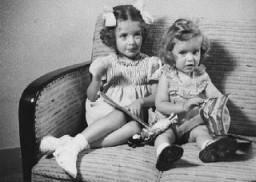
-
Jakub Lapides
ArticleYoung people's diaries bear witness to some of the most heartbreaking experiences of the Holocaust. Learn about the diary and experiences of Jakub Lapides.
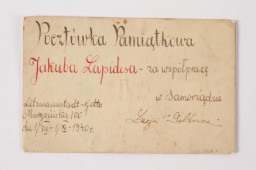
-
Hidden Children: Expressions
ArticleJewish children in hiding during the Holocaust created writing, art, diaries, and more. Read about the surviving documentation of their experiences.

-
Erika Eckstut
ArticleExplore Erika Eckstut's biography and learn about the difficulties and dangers she faced in the Czernowitz ghetto.
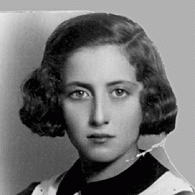
-
Henrietta and Herman Goslinski
PhotoIn 1942, Henrietta and Herman Goslinski went into hiding to avoid deportation from the Netherlands. Their rescuer could not, however, also take their infant daughter Berty. The Dutch resistance moved Berty frequently; she was eventually moved more than 30 times. During the two-and-a-half years apart, the parents saw Berty only once and received this single photograph of her taken while she was in hiding.

-
False identity for Kurt I. Lewin
DocumentKurt I. Lewin, who was Jewish, used this card while in hiding in a Ukrainian Greek Catholic monastery in German-occupied Poland (today Ukraine).
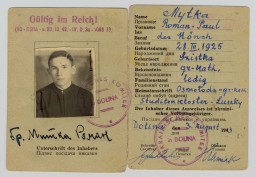
-
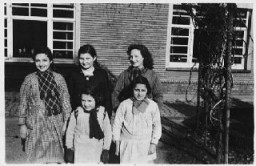
-
Estelle Laughlin
ArticleExplore Estelle Laughlin’s biography and learn about her experiences during the Warsaw ghetto uprising.
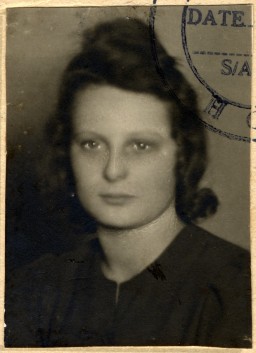
-
Norman Salsitz under an assumed identity
PhotoNorman Salsitz while under the assumed identity Tadeusz Zaleski. Legnica, Poland, 1945.
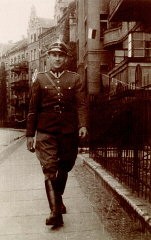
-
Edith Goldman Bielawski
ID CardEdith's parents owned a cotton factory in the town of Wegrow [in Poland]. The Goldmans were a religious family, and raised Edith, her brother and three sisters to strictly observe the Sabbath, Jewish holidays and the dietary laws. 1933-39: Edith attended public school, and also studied at the Beis Yakov religious school for girls where she learned Hebrew, the Bible and Jewish history. Her favorite hobby was knitting, and after finishing secondary school she learned the quilt-making trade. In the…
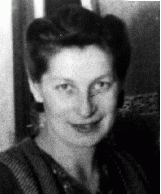
-
Portrait of three-year-old Estera Horn
PhotoPortrait of three-year-old Estera Horn wrapped in a fur coat. Chelm, Poland, ca. 1940. Estera was born in January 1937. Her father was killed soon after the Germans invaded Poland. Estera and her mother, Perla Horn, were forced into the ghetto in Chelm. At the end of 1942, during the liquidation of the ghetto, Perla and Estera escaped from the ghetto. They hid in nearby villages. In late 1943, Perla asked a family in Plawnice to take care of Estera. Perla tried to hide with a group of Jews in the nearby…
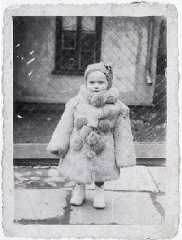
-
Ruth Elisabeth Dahl
ID CardRuth was born into an orthodox Jewish family in Geilenkirchen, a rural German town near the Dutch border. Her father, Isidor, was a respected cattle dealer in the area and her mother, Sophia, took care of the home. Ruth had two older siblings, Edith and Carl. 1933–39: When the Nazis came to power in Germany, life changed in Geilenkirchen. The townspeople supported the new regime and nobody helped their Jewish neighbors. Excluded from public institutions, Ruth attended a private Catholic school. In 1938,…
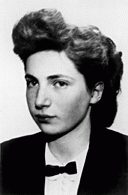
-
Klara Mintzberg
ID CardKlara grew up in Rzeszow, a Polish city with a population of approximately 30,000. The Mintzbergs were observant Jews. Klara's mother supported the family by running their fabric store. Her father was an ardent Zionist. He dreamed of immigrating to Palestine and encouraged Klara to join a Zionist youth group. 1933-39: After finishing secondary school, Klara was elected to serve on the board of directors of Poland's Ha-No'ar Ha-Ziyoni youth movement; she was the only woman on the board. She studied…
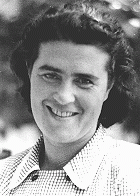
-
Fred Deutsch describes family's preparations for travel
Oral HistoryFred was born in Czechoslovakia in a town near the Polish border. Fred and his family were forced by the Germans to relocate east to a town bordering Slovakia. At the end of 1942, they escaped from the town and went into hiding. The family hid in bunkers in the forest until the end of the war. They moved every few weeks to avoid detection by the Germans or Slovak authorities. While the family was in hiding, Fred's grandfather made arrangements for Fred to attend school under an assumed name and religion. A…
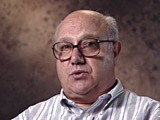
-
Gideon Frieder
ArticleExplore Gideon Frieder’s biography and learn about his experiences as a child during the Holocaust in Slovakia.
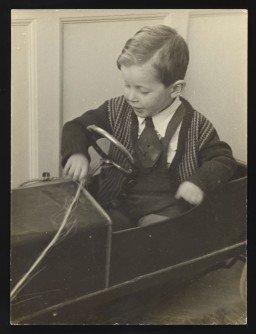
-
Hans Rudelsheim
ID CardHans was born to a Jewish family in the small Dutch town of Kampen. His father worked as a tailor, and he taught Hans about the tailoring trade. 1933-39: Hans was a skilled tailor, and an accomplished pianist as well. Inquisitive about all subjects, Hans loved to read and to keep abreast of current events. 1940-43: When the Jews in the Dutch provinces were ordered to relocate to Amsterdam in January 1942, the Rudelsheims complied. In early 1943, while in hiding with a Christian family near Leiden, Hans…
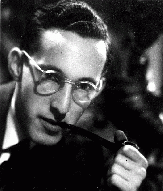
-
Leah Kohl Rapaport
ID CardLeah and her four brothers were raised in a religious Jewish family in the city of Lvov. After obtaining her high school diploma, Leah attended university for one year. In 1931 she married Joseph Rapaport, and the couple settled in Warsaw. 1933-39: The Rapaports lived in the suburbs, and Joseph worked as a banker. Their daughter Zofia was born in May 1933. Each year at the Jewish holiday of Passover, they returned to Lvov to visit Leah's parents. Two days after Joseph was mobilized for military duty in…

-
Helen (Helene Katz Wohlfarth) Waterford describes giving up her daughter to be sheltered
Oral HistoryAlthough originally from Germany, Helen was living in the Netherlands with her husband and young daughter when the Germans invaded in May 1940. Helen and her husband sent their daughter to non-Jewish friends, and went into hiding themselves. They stayed in a variety of places arranged by a friend who was active in the underground. On August 25, 1944, Helen and her husband were arrested. They were sent first to Westerbork and then to Auschwitz, where they were separated. Helen worked in the I. G. Farben…
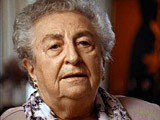
-
Lonia Goldman Fishman
ID CardLonia had three sisters and one brother. Her parents owned a cotton factory in the town of Wegrow. The Goldmans were a religious family, strictly observing the Sabbath, the Jewish holidays and the dietary laws. 1933-39: After studying all day at public school, Lonia attended a religious school for girls called Beis Yakov where she studied Hebrew, the Bible and Jewish history. Later, when she was in high school, a private tutor came to the house to teach her Hebrew. Lonia's favorite hobby was knitting.…
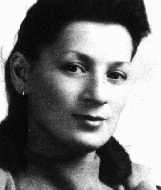
-
Sevek Fishman
ID CardSevek's religious Jewish family owned a haberdashery business in Kaluszyn, a suburb of Warsaw. The oldest of six children (three boys and three girls), Sevek completed high school and was then apprenticed to a tailor. 1933-39: Each Friday, before the Sabbath began, Sevek's mother asked the neighbors if they had enough food for the Sabbath. If they didn't, she brought them a meal. Although Sevek belonged to a non-religious Zionist group, Ha Shomer ha-Tsa'ir, and didn't wear a skullcap like religious Jews,…
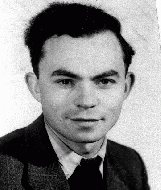
-
Sophie Turner-Zaretsky describes feeling different from other Polish children
Oral HistorySophie was born Selma Schwarzwald to parents Daniel and Laura in the industrial city of Lvov, two years before Germany invaded Poland. Daniel was a successful businessman who exported timber and Laura had studied economics. The Germans occupied Lvov in 1941. After her father's disappearance on her fifth birthday in 1941, Sophie and her mother procured false names and papers and moved to a small town called Busko-Zdroj. They became practicing Catholics to hide their identities. Sophie gradually forgot that…

-
Barbara Ledermann Rodbell describes receiving her first set of false papers
Oral HistoryIn 1933 Barbara's family moved to Amsterdam, in the Netherlands. They became friends of Anne Frank and her family. The Germans invaded the Netherlands in 1940. Barbara's boyfriend, Manfred, had underground contacts and she got false papers. Her mother, sister, and father were deported to Westerbork and then to Auschwitz. Barbara survived using her false papers and worked for the resistance. She helped take Jews to hiding places and also hid Jews in an apartment held in her false name.
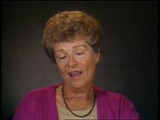
-
Sophie Turner-Zaretsky describes her years in Poland living under a false identity
Oral HistorySophie was born Selma Schwarzwald to parents Daniel and Laura in the industrial city of Lvov, two years before Germany invaded Poland. Daniel was a successful businessman who exported timber and Laura had studied economics. The Germans occupied Lvov in 1941. After her father's disappearance on her fifth birthday in 1941, Sophie and her mother procured false names and papers and moved to a small town called Busko-Zdroj. They became practicing Catholics to hide their identities. Sophie gradually forgot that…
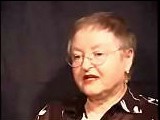
-
Eva, Alfred, and Leane Munzer
PhotoEva, Alfred, and Leane Munzer. Infant Alfred survived in hiding; his sisters were discovered and killed in Auschwitz.
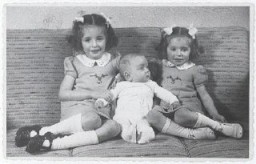
-
A Jewish child with a rescuer
PhotoA Jewish child, Jacky Borzykowski, with the priest who placed him in hiding on a farm. Belgium, 1943.
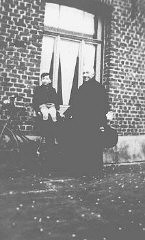
-
Doriane Kurz describes how she and her brother were hidden
Oral HistoryDoriane's Jewish family fled to Amsterdam in 1940, a year that also saw the German occupation of the Netherlands. Her father perished after deportation to Auschwitz. After their mother was seized, Doriane and her brother hid with gentiles. The three were reunited at Bergen-Belsen, where they were deported via Westerbork. They were liberated during the camp's 1945 evacuation. Doriane's mother died of cancer soon after Doriane helped her recover from typhus. Doriane and her brother immigrated to the United…
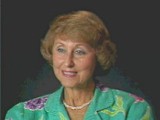
-
Jewish children in an orphanage after the war
PhotoAfter the war, thousands of Jewish children ended up in orphanages all over Europe as a result of the Holocaust. The toddlers in this children's home in Etterbeek, Belgium, survived in hiding, but their parents had been deported to Auschwitz.

-
Lida Kleinman
PhotoPortrait of a young Jewish girl, Lida Kleinman sitting in her room in Lacko, Poland, 1935. In January 1942, Lida was sent into hiding. She hid under false identities in Catholic orphanages until the end of the war.

-
Irene Freund
ID CardThe younger of two children, Irene was born to Jewish parents in the industrial city of Mannheim. Her father, a wounded German army veteran of World War I, was an interior decorator. Her mother was a housewife. When the Nazis came to power in 1933, Irene's older brother, Berthold, was attending public school. Three-year-old Irene was at home with her mother. 1933-39: Celebrating Jewish holidays with all of Irene's aunts and uncles was really nice. One of her favorite places was the zoo; she especially…
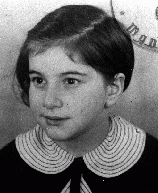
-
Alida Nathans Wijnberg
ID CardAlida was the oldest of eight children. Her parents, religious Jews, owned a textile business in the small town of Vries. As a teenager, Alida helped her family sell textiles to the local farmers, carrying the goods in a suitcase attached to the handlebars of her bicycle. She married Samuel Wijnberg, and the couple had three sons and a daughter. 1933-39: The Wijnbergs owned and lived in a kosher hotel in the town of Zwolle. It was the only kosher hotel in the region, so many Jewish businessmen and cattle…
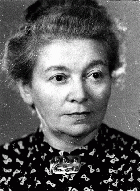
-
Page from Otto Wolf's diary
PhotoOtto Wolf (1927-1945) was a Czech Jewish teenager who chronicled his family's experience living in hiding in rural Moravia during World War II. His diary was published posthumously. This image shows book 4 of Otto Wolf's diary. This is the first entry by Felicitas Garda (Otto Wolf's sister) dated April 17, 1945. Felicitas continued Otto's diary after his disappearance.
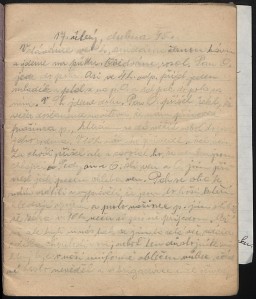
-
Sisters Eva and Liane Münzer
PhotoSisters Eva and Liane Münzer. They were placed in hiding with a devout Catholic couple. In 1944, Eva and Liane were reported to the police as a result of a fight between their rescuers. The husband denounced his wife and the two Jewish girls. The three were immediately arrested and sent to the Westerbork camp. On February 8, 1944, eight- and six-year-old Eva and Liane were deported to Auschwitz, where they were murdered. Photograph taken in The Hague, the Netherlands, 1940.

-
Raszka (Roza) Galek Brunswic describes a roundup in the Warsaw ghetto and her escape from deportation
Oral HistoryRoza's family moved to Warsaw in 1934. She had just begun college when Germany invaded Poland in 1939. In 1940, the Germans sealed the Warsaw ghetto, where her parents were shot during a roundup. Roza escaped and went into hiding. From her hiding place she saw the burning of the ghetto in the 1943 uprising. She had false papers stating she was a Polish Catholic (Maria Kowalczyk), and was deported by cattle train to Germany in June 1943. She worked on a farm until liberation in 1945.
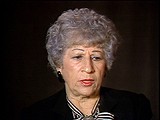
-
Polish family who hid a Jewish girl
PhotoMembers of a Polish family who hid a Jewish girl on their farm. Zyrardow, Poland, 1941-1942.
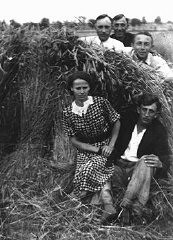
-
Rosa Israel Waldhorn
ID CardRosa was one of 14 children born to religious Jewish parents in the village of Yasinya at a time when it was known as Korosmezo and was part of Hungary. During World War I, she married Michael von Hoppen Waldhorn, an officer in the Austro-Hungarian army who was based near Yasinya. During the 1920s they moved to Paris, where they raised three children. 1933-39: The Waldhorn family's life in Paris was very different from their life in Hungary and Czechoslovakia. Rosa's husband made a good living, and he…
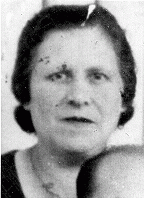
-
Leah Hammerstein Silverstein describes working under a false non-Jewish identity in a German hospital in Krakow
Oral HistoryLeah grew up in Praga, a suburb of Warsaw, Poland. She was active in the Ha-Shomer ha-Tsa'ir Zionist youth movement. Germany invaded Poland in September 1939. Jews were forced to live in the Warsaw ghetto, which the Germans sealed off in November 1940. In the ghetto, Leah lived with a group of Ha-Shomer ha-Tsa'ir members. In September 1941, she and other members of the youth group escaped from the ghetto to a Ha-Shomer ha-Tsa'ir farm in Zarki, near Czestochowa, Poland. In May 1942, Leah became a courier…

-
Robert Gruber
ID CardRobert was raised by Hungarian-speaking parents in Kosice, a town in eastern Slovakia with a sizable Jewish community of 7,000. The Grubers were a traditional Jewish family and they observed the Jewish Sabbath, dietary laws, and holidays. Robert's father owned a small jewelry shop. 1933-39: When Robert was 5, Kosice was taken over by the Hungarians, who were led by a dictator named Horthy. He stood on the main street with his parents, watching the soldiers march into town in a victory parade. They were…
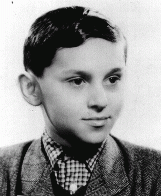
-
A mother's photograph
PhotoParting from one's child was a difficult experience for parents who placed their offspring with foster families. Eda Künstler entrusted this photograph of herself to her daughter's rescuer, Zofji Sendler. On the back it is inscribed, "Anita's real mother."
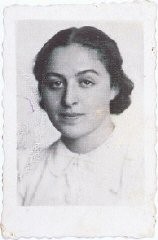
-
Six Jewish girls who were hidden in a convent
PhotoSix Jewish girls hidden from the Nazis at the Dominican Convent of Lubbeek near Hasselt. Belgium, between October 1942 and October 1944.
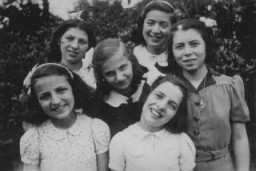
-
Marcus Fass
ID CardMarcus, known to his family as Moniek, was one of three children born to a Jewish family in the Polish town of Ulanow. His father worked as a tailor. Ulanow's Jewish community had many of its own organizations and maintained a large library. From the age of 3, Moniek attended a religious school. He started public school when he was 7. 1933-39: In 1935 Moniek's father left for America to find a job so that his family could later join him. He sent money to them while they waited for their emigration papers.…

-
Sisters Eva and Liane Münzer
PhotoDenunciations of Jews to German authorities came from a variety of different sources, sometimes even from their "protectors." In 1944, Eva and Liane Münzer (pictured here) were reported to the police as a result of a domestic fight between their rescuers. The irate husband denounced his wife and the two Jewish girls. The Münzer sisters were sent to Auschwitz and killed.
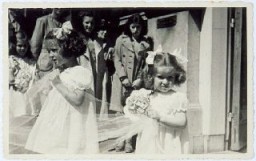
-
Portrait of a boarding school class in which a Jewish boy was hidden
PhotoClass photograph of students at the San Leone Magno Fratelli Maristi boarding school in Rome. Pictured in the top row at the far right is Zigmund Krauthamer, a Jewish child who was being hidden at the school. Rome, Italy, 1943–44.

